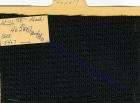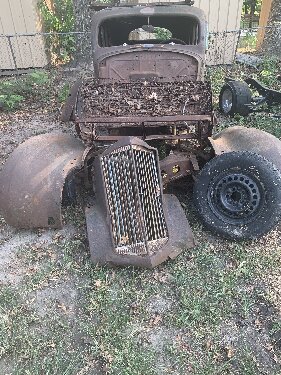|
Re: Lug and Axle Nut Torque
|
||||
|---|---|---|---|---|
|
Forum Ambassador

|
I don't know of anyone who actually uses a torque wrench on wheel lug bolts, we just tighten them really tight, but the specification is 85-95 ft-lbs.
For the front wheel bearing spindle nut: 1. Tighten to 20 ft-lbs (to seat the bearings and races). 2. Back off the nut until loose, retighten to 4 ft-lbs. 3. Back off 1 hex, and then back of again to the nearest cotter pin slot. PS - you may find this technique incorrectly stated in the shop manual, it was later corrected in a Service Counselor. Getting it "right" is really critical to good bearing life. Most mechanics of the era and today just "free-style" it, after making sure the bearins and races are seated, just adjusting until there is just a barely imperceptible degree of looseness.
Posted on: 2014/3/30 12:55
|
|||
|
||||
|
Re: Lug and Axle Nut Torque
|
||||
|---|---|---|---|---|
|
Home away from home
|
Owen..Thank You! I am all squared away and will file this info for future ref. Thanks for the tip about the correction to the service manual. Wheel tightness on spindle feels perfect.
Warren
Posted on: 2014/3/30 14:17
|
|||
|
||||
|
Re: Lug and Axle Nut Torque
|
||||
|---|---|---|---|---|
|
Home away from home

|
Hey Steve:
If you don't have a torque wrench then 100 ft lbs translates as follows: Run the wheel lugs using a socket until they are seated hand tight on the wheel. After they are hand tight use a lug wrench or ratchet and tighten 1/4 quarter turn. Over tightening wheel bolts galls the threads and distorts the drums. There are lots of different methods for wheel bearings if you don't have a torque wrench. The most important item is to have no contact with the brake shoes and no tire on the drum. The old General Motors method was to tighten the nut while rotating the wheel opposite direction until the bearing begins to pre-load (drag) (around 22-25 ft lbs) then back of and tighten finger tight. Ford had a similar method but specified backing off and tightening something like 15 inch pounds. After you do this you can finish using the Packard method.
Posted on: 2014/3/30 15:46
|
|||
|
||||
|
Re: Lug and Axle Nut Torque
|
||||
|---|---|---|---|---|
|
Home away from home
|
Really tight and 85-95 ft-lbs don't go together in my book. Really tight is about twice that ~160+. Really really tight is over 200 for me.
I (the anti - OD) use a torque wrench on all my lug nuts. I carry with me on the road. The tire shop (on the road) put the big air gun on my trailer (alloy wheels - 50 ft-lbs) and stripped out most all the studs. Didn't find until I was doing routine maintenance and had to factory order studs. I carry two sets of spares of everything. In the garage, I have my 1/2" impact set so it's about 125 ft-lbs full out which is what is called for on my other vehicles. My Packard has lug bolts not nuts. I recall nk the torque spec was in the literature. I think everyone has their own method on wheel bearings. I've yet to find a torque wrench for the few ft-lbs they usually call for. I don't like "positions" for tightness. I spin and tighten til it stops, to make sure the bearings are seated, then back off til it just spins freely. Go to the next looser cotter hole. I recheck after a few thousand miles before can do much damage. The seal will go first. Main thing is to use the proper /good quality grease/lubricant. I have oil bath wheels on the trailers.
Posted on: 2014/4/1 21:41
|
|||
|
||||
|
Re: Lug and Axle Nut Torque
|
||||
|---|---|---|---|---|
|
Home away from home
|
We do the same thing on airplane bearings, tight then loose until it spins free, then next hole looser. Kinda critical there because the wheels are going from 0 to 120mph in a heartbeat on landings.
Posted on: 2014/4/1 23:36
|
|||
|
1952 Model 200 Deluxe Touring Sedan
HA's 52 Grey Ghost "The problem with quotes on the internet is you never know if they're true" - Abraham Lincoln |
||||
|
||||
|
Re: Lug and Axle Nut Torque
|
||||
|---|---|---|---|---|
|
Home away from home
|
People got to realize that in dry torquing greater than 50% of the applied torque goes to overcome friction (thread and head) and is not tightening the bolt, per se. It's all in the literature. So you might think you're tightening the bolt but it could be something else requiring all that force.
They've kinda come to doing wet torquing, since alot of aluminum and studs are out there now, with "wet" vs "dry" because you get the proper tensile with much less torque. Al is easy to strip out. There's a chart for wet vs dry too. Look it up. We used those hydraulic torquers guys for the critical "big bolts", it's a science now.
Posted on: 2014/4/5 18:32
|
|||
|
||||
|
Re: Lug and Axle Nut Torque
|
||||
|---|---|---|---|---|
|
Home away from home

|
There are torque tools for everything right down to torque screwdrivers for carburetors and fuel pumps.
If you want to spend the money you can buy a torque limiting extension from the NAPA catalogue. Good tire shops use them, but good shops also use torque wrenches. I've seen them being used, so not all places are a nightmare. Experienced mechanics have figured the approximate torque they are applying with a short burst from an impact. The current preferred method is to torque threads wet, but wheel lugs are not so specified. The present methods for motors is torque to yield which is more uniform than a torque wrench. Rolls-Royce was using torque to yield as far back as the Ghost. The objective with backing off on wheel bearings is to compensate for expansion. So the optimum amount depends on operating conditions. The ideal method is to measure endplay using a dial indicator; typical figures are less than .005.
Posted on: 2014/4/5 20:09
|
|||
|
||||








